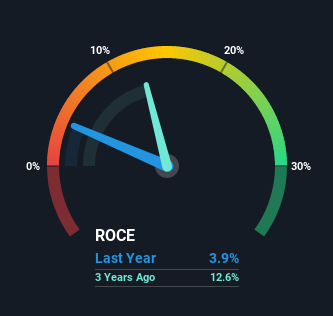Be Wary Of Northern Bear (LON:NTBR) And Its Returns On Capital
What financial metrics can indicate to us that a company is maturing or even in decline? A business that's potentially in decline often shows two trends, a return on capital employed (ROCE) that's declining, and a base of capital employed that's also declining. Trends like this ultimately mean the business is reducing its investments and also earning less on what it has invested. On that note, looking into Northern Bear (LON:NTBR), we weren't too upbeat about how things were going.
Return On Capital Employed (ROCE): What is it?
Just to clarify if you're unsure, ROCE is a metric for evaluating how much pre-tax income (in percentage terms) a company earns on the capital invested in its business. To calculate this metric for Northern Bear, this is the formula:
Return on Capital Employed = Earnings Before Interest and Tax (EBIT) ÷ (Total Assets - Current Liabilities)
0.039 = UK£971k ÷ (UK£38m - UK£13m) (Based on the trailing twelve months to September 2021).
So, Northern Bear has an ROCE of 3.9%. In absolute terms, that's a low return and it also under-performs the Consumer Durables industry average of 10%.
See our latest analysis for Northern Bear
While the past is not representative of the future, it can be helpful to know how a company has performed historically, which is why we have this chart above. If you're interested in investigating Northern Bear's past further, check out this free graph of past earnings, revenue and cash flow.
How Are Returns Trending?
There is reason to be cautious about Northern Bear, given the returns are trending downwards. To be more specific, the ROCE was 10.0% five years ago, but since then it has dropped noticeably. And on the capital employed front, the business is utilizing roughly the same amount of capital as it was back then. Since returns are falling and the business has the same amount of assets employed, this can suggest it's a mature business that hasn't had much growth in the last five years. So because these trends aren't typically conducive to creating a multi-bagger, we wouldn't hold our breath on Northern Bear becoming one if things continue as they have.
The Bottom Line On Northern Bear's ROCE
In the end, the trend of lower returns on the same amount of capital isn't typically an indication that we're looking at a growth stock. Investors must expect better things on the horizon though because the stock has risen 35% in the last five years. Either way, we aren't huge fans of the current trends and so with that we think you might find better investments elsewhere.
Northern Bear does have some risks, we noticed 3 warning signs (and 1 which is a bit unpleasant) we think you should know about.
If you want to search for solid companies with great earnings, check out this free list of companies with good balance sheets and impressive returns on equity.
This article by Simply Wall St is general in nature. We provide commentary based on historical data and analyst forecasts only using an unbiased methodology and our articles are not intended to be financial advice. It does not constitute a recommendation to buy or sell any stock, and does not take account of your objectives, or your financial situation. We aim to bring you long-term focused analysis driven by fundamental data. Note that our analysis may not factor in the latest price-sensitive company announcements or qualitative material. Simply Wall St has no position in any stocks mentioned.
Have feedback on this article? Concerned about the content? Get in touch with us directly. Alternatively, email editorial-team (at) simplywallst.com.

